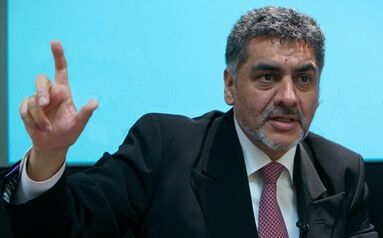Sweet Trials(英)
|
If I thought any of you had any opinion about the guilt of my clients, I wouldn't worry, because that might be changed. What I'm worried about is prejudice. They are harder to change. They come with your mother's milk and stick like the color of the skin. I know that if these defendants had been a white group defending themselves from a colored mob, they never would have been arrested or tried. My clients are charged with murder, but they are really charged with being black. --Clarence Darrow, 11/24/25. The automobile and manufacturing boom that began in Detroit about 1915 made the city a magnet for blacks fleeing the economic stagnation of the South. In the decade from 1915 to 1925, Detroit's black population grew more than tenfold, from 7,000 to 82,000. A severe housing shortage developed, as the city's compact black district could not accommodate all the new arrivals. Blacks brave enough to purchase or rent homes in previously all-white neighborhoods faced intimidation and violence. The spring and summer of 1925 saw several ugly housing-related incidents. In April, 5000 people crowded in front of a home on Northfield Avenue, throwing rocks and threatening to burn the house down. "The house is being rented by blacks," someone in the crowd explained to police arriving at the scene. Two months later, Dr. Alexander Turner, a black physician, purchased an expensive brick home on Spokane Avenue. Minutes after the Turner's moving van arrived at his new home, an angry crowd gathered. Windows shattered as brick, potatoes and other missiles were hurled at the home. Within hours, two white men--from an organization called the Tireman Avenue Improvement Association--entered Turner's home and asked, "Will you sell the property back to us?" Fearing for his life, Turner agreed to sell. The next month, John Fletcher and his family were the targets of mob violence. The Fletchers had just sat down to a meal in their new home on Stoepel Avenue when they were spotted through a window by a passing white woman. The woman began to yell, "Niggers live there! Niggers live there!" Soon a crowd of 4000 had gathered. Some in the crowd yelled, "Lynch them!" Chunks of coke smashed through windows. Two shots rang out from the Fletcher's home. One struck a teenager in the thigh. Police arrested the Fletchers--they would move out the next day. It was in this violent summer of 1925 that a black doctor named Ossian Sweet purchased a home at 2905 Garland, in an all-white middle-class neighborhood. Although Sweet originally planned to move his family into the new home in July, he postponed the move for two months in the hopes that racial tensions might ease. They didn't. On July 12, 1925, the Detroit Free Press carried a paid announcement: To maintain the high standard of the residential district between Jefferson and Mack Avenues, a meeting has been called by the Waterworks Improvement Association for Thursday night in the Howe School Auditorium. Men and women of the district, which includes Cadillac, Hurburt, Garland, St. Clair, and Harding Avenues, are asked to attend in self-defense. Two days later, seven hundred white residents of the district crammed into the Howe School Auditorium to discuss the rumored move of a black family into 2905 Garland. The principal speaker for the meeting was a representative from the Tireman Association, the group that had successfully driven Dr. Turner from his new home the month before. The loudest cheer of the evening came in response to the speaker's contention, " Where the nigger shows his head, the white must shoot." Despite being aware of the danger, Dr. Sweet decided to move his family into his Garland Avenue home on September 8. Ossian Sweet explained his decision to his brother: "I have to die like a man or live a coward." Before moving in, Sweet prepared himself for the mob he expected to face. He bought nine guns and enough ammunition for all of them. He notified Detroit police of his planned move and asked for protection. He left his infant daughter at his wife's mother's home. Finally, he arranged to have his younger brothers, Henry and Otis, as well as some of their friends, join him and his wife Gladys for their first perilous night on Garland Avenue. The night of September 8 passed without serious incident. A crowd of 100 to 150 people remained in front of the Sweet house for much of the night, but except for one barrage of rocks thrown against the house around 3:00 A.M., no violence occurred. As one of the occupants of the Sweet house departed the next morning, one member of the mob still in front of the home told him, "The crowd had a meeting last night at the confectionery store....They say you better get out of here tonight." Hearing the report of possible violence, Ossian Sweet recruited three young friends join them for the night of September 9. The next evening was hot. Gladys Sweet worked in the kitchen preparing a meal of roast pork, sweet potatoes and mustard greens. Ossian Sweet and his acquaintances played cards. Someone in the house exclaimed, "My God, look at the people!" The Sweets looked out through their windows and a screen door to see a swelling crowd--filling the nearby steelyard, the space around a grocery store, the alley, the porches of nearby homes. According to the Sweets, stones began flying. They were gripped with fear. Around 8 o'clock a taxi cab pulled up in front of the Sweet home. Ossian's brother Otis and a friend emerged from the cab to hear cries of "Niggers! Niggers! Get the damn niggers!" As he opened the door to let them in, Ossian Sweet said later, "the whole situation filled me with an appalling fear--a fear that no one could comprehend but a Negro, and that Negro one who knew the history behind his people." The Sweets pulled down the blinds and waited. Rocks hit the house. One smashed through an upstairs window. At 8:25, a fusillade of shots rang out from the upper floor and back porch of the Sweet home. One of the bullets struck thirty-three-year-old Leon Breiner in the back as he stood on the porch of 2914 Garland, talking to friends. Breiner's last words were, "Boys, they've shot me." Police covered Breiner with a blanket and took him away. Nearby, another man, Eric Houghberg, lay with a bullet wound to the leg. Six policeman (who had been present at the house at the time of the shooting) entered the Sweet home, flung up all the shades, turned on all the lights, and arrested the eleven occupants. At police headquarters, the Sweets and their house guests were told for the first time that a man had been killed and a boy wounded. Each of the arrested persons was interviewed separately. They gave wildly different accounts of events. Some claimed to have been sleeping at the time of the shooting; one claimed to have been taking a bath. Ossian Sweet admitted having distributed a gun to each male occupant, while some of those interviewed denied any knowledge of guns. At about 3:30 A.M., an assistant prosecutor informed them that he planned to recommend first degree murder warrants against all eleven. On September 16, at a preliminary hearing, Judge John Faust denied bail for all defendants. Following the hearing, thirty-five-year-old Judge Frank Murphy, the presiding judge of Recorder's Court, assigned himself to the trial of the Sweet case. Murphy explained that he took the case because "every judge on this bench is afraid....they think its dynamite." He also admitted to a more self-serving reason for wanting the trial: "[The other judges] don't realize this is the opportunity of a lifetime to demonstrate sincere liberalism and judicial integrity at a time when liberalism is coming into its own." Murphy set October 30 as the date for the start of the trial. Meanwhile, efforts were underway to put together a first-rate defense team. After learning of the mass arrest in Detroit, the NAACP had sent Walter White, its assistant secretary, to Michigan on a fact-finding mission. After completing his assignment, White returned to New York where he met with Arthur Garfield Hays, a noted civil rights attorney, and Clarence Darrow, the most famous defense attorney of the time, and urged them to take the Sweet case. It didn't take much urging. Darrow and Hays arrived in Detroit on October 12. They went to the Detroit jail, were ushered up two flights of stairs, and in a small, poorly lit room with a table and broken chairs, met their clients for the first time. Hays described the clients reaction to their visit as being "cheered, but not hopeful." Darrow and Hays--according to Hays' account--"concluded that the only defense lay in making a clean breast of the whole matter," but found their clients "evasive" and unwilling to talk. According to Hays, they "had a very human desire to support their original and inept stories." The only one of the bunch who seemed to want to talk about the incident "was rather proud of the fracas--the whites had learned a lesson." Gradually, however, Hays and Darrow were able to piece together a plausible story of the events of September 9. After a week of jury selection, assistant prosecutor Lester S. Moll delivered his opening statement to the all-white jury. He described a peaceful neighborhood whose tranquility was shattered by an unprovoked barrage of gunfire. Moll conceded that blacks had a civil right to live wherever they chose, but suggested to the jury that the most important civil right of all is the right to live--a right Leon Breiner forfeited on September 9 as he amiably smoked his pipe on a neighbor's porch. This is not a case about racial prejudice, Moll told the jury--it is a case about premeditated murder. As Moll delivered his opening statement, Clarence Darrow ostentatiously worked on a crossword puzzle. The State would call seventy witnesses in the Sweet trial. Most would testify that the crowd outside the Sweet home was small and orderly prior to the shooting. Many said it was "curiosity" that had brought them to the corner of Garland and Charlevoix. Some, such as neighbor Ray Dove, admitted on cross-examination that they didn't "believe in the mixing of blacks and whites" and objected to the Sweets living in their new home. One witness (Edward Weltlauffer) admitted to hearing "cracking of glass" one minute before the firing. A police sergeant testified that he "talked to Dr. Sweet the morning before the shooting" and informed him that five men had been sent to his house to "protect the property." Patrolmen Frank Gill testified that he saw two black men firing from the back porch of the Sweet home in different directions. Florence Ware said she saw "ten or so" shots come from the upper bedroom. Arthur Garfield Hays gave the opening statement for the defense. He asked each member of the Sweet family to stand as he gave a short biographical sketch of each. "They don't look like murderers," he suggested to the jury. Hays introduced the defense's theory of the case: We shall show not only what happened in the house, but we shall attempt a far more difficult task-that of reproducing in the cool atmosphere of a courtroom, a state of mind-the state of mind of these defendants, worried, distrustful, tortured and apparently trapped-a state of mind induced by what has happened to others of their race, not only in the South where their ancestors were once slaves, but even in the North in the States which once fought for their freedom. Beginning with their first witness, Alonzo Smith, a black passenger in a car that had been attacked by the mob as it passed through the Garland Avenue district, Darrow and Hays tried to paint a very different picture of the scene around the Sweet home on September 9. Smith described people in the crowd he estimated at one thousand yelling, "Here's a nigger now. Kill him. He's going to the Sweets." Other defense witnesses testified that they saw persons in a large crowd throwing stones at the Sweet home. Darrow and Hays saw the testimony of Ossian Sweet as the most critical to their case. It would be through his testimony that they would attempt to show the jury the fear that existed in the minds of the defendants on the night of the shooting. Asked to state his "state of mind at the time of the shooting," Sweet replied, "When I opened the door and saw the mob I realized I was facing the same mob that hounded my people throughout its entire history." Prosecutor Robert Toms asked Judge Murphy to exclude the defense's state-of-mind evidence as it related to race: "Is everything this man saw as a child justification for a crime twenty-five years later?" Darrow responded: This is the question of the psychology of a race--of how everything known to a race affects its actions. What we learn as children we remember--it stays fastened in the mind....Because the defendant's actions were predicated on the psychology of his past, I ask that this testimony be admitted. Judge Murphy ruled that the state-of-mind testimony could be considered by the jury. Sweet provided a riveting account of the events around 8:30 on September 9: We were playing cards; it was about eight o'clock when something hit the roof of the house. Somebody went to the window and then I heard the remark, "The people, the people." I ran out to the kitchen where my wife was. There were several lights burning. I turned them out and opened the door. I heard someone yell, "Go and raise hell in front, I'm going back. I was frightened, and after getting a gun, ran upstairs. Stones kept hitting our house intermittently. I threw myself on the bed and lay there a short while. Perhaps fifteen minutes, when a stone came through the window. Part of the glass hit me. Pandemonium--I guess that's the best way of describing it--broke loose. Everyone was running from room to room. There was a general uproar. Somebody yelled, "There's someone coming!" They said, "That's your brother." A car had pulled up to the curb. My brother and Mr. Davis got out. The mob yelled, "Here's niggers! Get them, get them!" As they rushed in, the mob surged forward fifteen or twenty feet. It looked like a human sea. Stones kept coming faster. I ran downstairs. Another window was smashed. Then one shot. Then eight or ten from upstairs; then it was all over.... Robert Toms asked why his courtroom testimony differed from that given to police on the night of his arrest. "I am under oath now," Sweet answered. "I was very excited then and afraid that what I said might be misinterpreted." Lester Moll offered the first closing argument for the State. He described the defense's "fear complex theory" as "poppycock." He accused Darrow of trying to present a "dissertation on race relations since the remotest time." In his closing argument, Clarence Darrow asked jurors to put aside their racial prejudices: You are facing a problem of two races, a problem that will take centuries to solve. If I felt none of you were prejudiced, I'd have no fear. I want you to be as unprejudiced as you can be.....Draw upon your imagination and think how you would feel if you fired at some black man in a black community, and then had to be tried by them. Darrow told the jury the danger the Sweets faced that night was real: The danger of a mob is not what it does, but what it might do. Mob psychology is the most dreadful thing with which man has to contend. Its action is like the starting of a prairie fire. A match in the stuble, and it spreads and spreads, devouring everything in its way....the mob was waiting to see the sacrifice of some helpless blacks. They came with malice in their hearts... The final closing argument belonged to Prosecutor Toms. Toms told the jury "It isn't your business to settle [the race problem]." He asked them to remember that this "this courtroom is just a tiny speck in the world" and that there "are other worlds to consider." Darrow, he said, "doesn't want to look at it as a criminal case, but as a cross-section of human nature. But that's what were here for." He disputed Darrow's claim that the people gathered outside the Sweet home had malice in their hearts: "There is no scintilla of evidence to show that the Association banded together to drive Negroes out of the neighborhood." In his instructions to the jury, Judge Murphy told the twelve men that "all men are equal under the law, whether they be rich or poor, black or white, humble or great. It is the duty of each of you to reach for justice." At 3:30 on November 25, 1925, the case went to the jury. As the jury deliberated the rest of that day and all of the next (Thanksgiving), "Darrow lolled on a sofa in the judge's office and confessed to being very tired." He told a reporter for the Detroit Free Press that he expected the jury to have difficulty in reaching its decision. From the judge's chambers, voices of the jury--often raised in heated debate--could be heard. Debate quieted when a "splendid turkey with fixings" was delivered to the juryroom. The next day the jury, after deliberating for forty-six hours, told Judge Murphy that they thought it would be impossible to reach a verdict in the case. Murphy dismissed the jury and declared a mistrial. According to reports, seven of the jurors had favored conviction (for manslaughter) for Ossian and Henry Sweet, five favored acquittal. For the other defendants, the vote was ten to two in favor of acquittal. Darrow hoped that the hung jury would convince Robert Toms to drop charges. He was soon disappointed. Toms announced plans to proceed with a second trial. After Darrow moved to have the defendants tried separately, Toms decided to proceed first with a retrial of Henry Sweet, Ossian Sweet's younger brother, who had admitted firing shots out the front window in the direction of Leon Breiner. Released on bail, the Sweets chose not to return to their Garland Avenue home. The home was set on fire that winter of 1925-26, but the blaze was extinguished quickly and the house escaped serious damage. Darrow returned to Detroit in April, 1926, to prepare for the Henry Sweet trial. Darrow told reporters that he liked Detroit--especially because of its proximity to Windsor, Ontario, where the Prohibition Amendment had no force. Moreover, he looked forward to another trial before Judge Murphy, who he called "the kindliest and most understanding man I have ever happened to meet on the bench." Darrow--uncharacteristically--even had good things to say about the prosecutors. He described Toms as "one of the fairest and most humane prosecutors I have ever met." The second trial proceeded much as the first--though "more smoothly," according to Darrow. The most important difference between the two trials lay in Darrow's final plea. Darrow called his eight-hour summation in the Henry Sweet trial "one of the strongest and most satisfactory arguments that I have ever delivered." Marcet-Haldeman Julius offered this impression of Darrow's closing: Twice he almost concluded, and then, as if some deep instinct warned him that he had not yet said quite all-that perhaps he had left uncovered in the minds of those men before him some tiny point upon which might hinge that kind, splendid young colored chap's whole future-he would go on. Few of us will ever forget the picture of him as he stood, worn after the long day of intense, if for the most part quiet, pleading. With arm uplifted, on a level with his breast, hand out-spread in that typical gesture of his when he wants his listeners to concentrate, his eyes searching the very hearts of the member before him, he spoke once more of the long road ahead of the Negro, of the sorrows, the tribulations, that confronted him, urged the jury not to put anything further in his way; impressed upon them the desperate need both white and colored folk had for sanity and courage. "I ask you, gentlemen," he said, "in behalf of the progress and understanding of the human race that you return a verdict of 'Not Guilty.'" To many of us he seemed like one of the prophets of old come to speak a word of warning and of guidance. As Judge Murphy left the bench, he took a friend's hand and said, "This is the greatest experience of my life. That was Clarence Darrow at his best. I will never hear anything like it again. He is the most Christlike man I have ever known." Robert Tom's summed up for the prosecution the next morning, and the jury was sent off to begin its deliberations. It did not take long. Four hours after they began discussions, the jury door was unlocked and twelve men, in single file, marched into the courtroom. "Have you gentlemen in the course of your deliberations reached a verdict in the case of Henry Sweet? And if so, who will answer for you?" The jury foreman, George Small, the young Detroit manager of Cunard Anchor Lines, responded, "We have and I will." Small cleared his throat. "Not guilty," he said, as his voice broke. Tears rolled down the cheeks of Clarence Darrow and Henry Sweet. |








